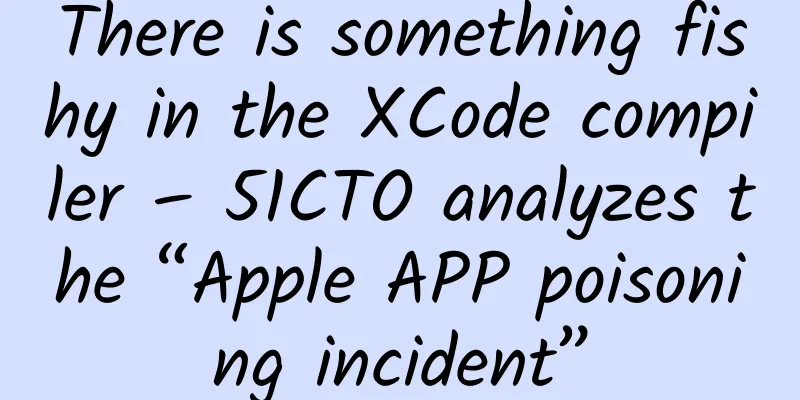There is something fishy in the XCode compiler – 51CTO analyzes the “Apple APP poisoning incident”

|
A virus hidden in the XCode compiler celebrates the birthday of the newly released iOS9. This is not the first time that Apple has been infected, but if you search Baidu for the question "Can Apple be infected with viruses?", the vast majority of the answers are: Not at all without jailbreaking. Indeed, the WireLurker that was popular last year only infected 300,000 users, which is not worth mentioning for the tens of millions of Apple users in China. This time, the situation is much more serious. On the morning of September 17, Weibo user @JoeyBlue_ revealed that an application compiled by a developer using Xcode downloaded from an unofficial channel was injected with third-party code and would upload data to a website. 51CTO reporter learned from Wuyun Knowledge Base author Zhengmi at *** time that the injected virus sample "XcodeGhost" was analyzed and confirmed the above statement. After analysis, the virus will collect basic information of applications and systems, including time, bundle id (package name), application name, system version, language, country, etc., and upload it to init.icloud-analysis.com (the domain name is applied by the virus author for collecting data information). Subsequently, on the morning of the 18th, Silicon Valley security company Palo Alto tracked the incident and discovered that the well-known domestic application NetEase Cloud Music was infected. The latest version of NetEase Cloud Music v2.8.3 currently on the App Store has been infected with the virus and will upload the mobile phone's private information to the virus author's server (Palo Alto also found more domain names for collecting data). The problem is that there are many links from the development of an APP to its launch on the user's phone. So how did this virus hidden in the XCode compiler pass all the reviews? Unhindered virus As mentioned above, the virus was hidden in the XCode compiler downloaded from a third party, which led to a disaster. Wang Biao, a white hat of Wuyun, told reporters: "Due to poor user experience, such as insufficient network optimization, many developers feel that the speed of downloading official plug-ins from the Mac App store is much slower than that of network disk and Xunlei, so they choose to download from third parties." However, after an APP is developed, it is theoretically necessary to conduct a security check. For this virus, you only need to do a simple cloud data test to detect whether the data is returned to you to find the virus. Wang Biao said: "Especially when it comes to sensitive user data and payment services, it is a very serious matter if losses are caused to users due to negligence." In addition, unlike websites, the cost of updating APPs is higher. Most APPs will provide support for old versions. If security testing is not done well at the beginning of the launch, the damage to users will undoubtedly be huge and long-term. Then again, the App Store's review is extremely strict, so Android apps are much safer and more standardized than those in third-party app stores. Why did this virus also fool the App Store? Wang Biao analyzed: "Because this virus collects information including time, bundle id (package name), application name, system version, language, country, etc., and no sensitive user information has been seen so far, and some domestic apps also collect the same information, Apple may have been negligent and allowed the virus to take advantage of the situation. The long-hanging sword of Damocles At this point, the situation is roughly clear. Every process from development to launch happened to be exploited by the virus. Of course, the information security issue has not been around for a day or two. It is like a sword of Damocles hanging over the heads of users and apps. Fortunately, Wang Biao told reporters that the virus hidden in the XCode compiler has not yet been seen to collect sensitive information of users, so everyone can rest assured. However, it is also recommended that Apple users turn on the iCloud two-step verification function to strengthen their own safe usage habits. Safety issues are always on the lips but never on the agenda. Attached is the inspection method (from Wuyun) Malicious Xcode contains the following file: “/Applications/Xcode.app/Contents/Developer/Platforms/iPhoneOS.platform/Developer/SDKs/Library/Frameworks/CoreServices.framework/CoreService”; the normal Xcode SDK directory does not have a Library directory (from @JoeyBlue_) Secondly, you should also check the settings of Target->Build Setting->Search Paths->Framework Search Paths to see if there are any suspicious frameworks mixed in (from Zhengmi) |
>>: Crashing Google Chrome? Just 16 bytes!
Recommend
A collection of operating methods for self-media platforms such as Baijiahao and Toutiaohao!
When Internet information became the most importa...
Smart home enters the platform stage, Xiaomi and Haier take the lead
With Google's acquisition of Nest for $3.2 bi...
Guangzhou Distribution Mini Program Mall, how long does it take to produce a distribution mini program?
As of now, the number of mini programs has reache...
How many pixels does your camera really need?
Technology is advancing at a rapid pace, which ra...
B station marketing promotion rules
After manually restoring the Sanxingdui golden ma...
From iPhone 7 to Huawei P10, what is the secret behind the non-pressable Home button?
If 2016 is the year when Type-C was fully populari...
My ankles ache slightly when it rains. Is this a disease?
Author: Tang Qin, Researcher of Chinese Medical A...
Future iPhones may use under-screen light sensors to reduce the size of the notch
Apple is working on an ambient light sensor that ...
Schools of programming
[[142408]] There are always people who like to ar...
Fold up the small table, open the sunshade...Why are there so many "strange" rules when flying?
Compared to taking a train or a car, taking a pla...
Can low GI foods really help you lose weight? Find out the truth in this article!
The ten pounds lost in the summer have not been l...
What growth methods did these super apps and websites use in their early years?
How can we achieve user growth organically and ac...
Cognition and scale—how do operations intervene in products?
Products and operations may indeed conflict over ...
The diagnostic criteria for hypertension have changed! Check yourself →
On November 13, the "Chinese Hypertension Cl...
Shanghai has recovered. Has the psychological crisis under the lockdown also recovered?
From 00:00 on June 1, 2022, Shanghai fully restor...





![[Case Study] Details behind an H5 campaign with 130 million UVs revealed!](/upload/images/67cc1b352e7fb.webp)



